|
A visit to the home
of the Original "Galileo" Telescopes
The Institute and Museum of the History of
Science Florence Italy
and a brief outline of some of the issues of making an
accurate replica for museum display.
See More Detail of the trip to the
IMSS Museum, Florence &Venice
|
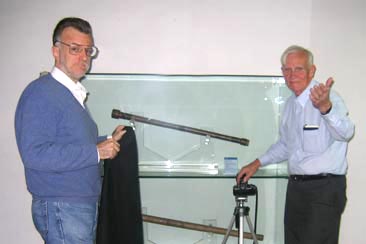 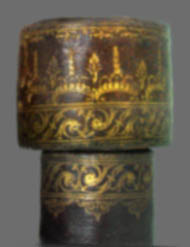
|
Dr.
Strano, curator at the IMSS, who was a rich source of
technical information & Jim in front of
the case displaying two Galilean
telescopes that were built within the
year of his great discoveries of the moons
of Jupiter and the craters and mountains
of our Moon. |
The
objective end of the famous Number 2
telescope, IMSS #2428, with its beautiful art work. |
|
A trip to the IMSS
in Florence Italy to take pictures, view pictures in the
archives, and make
measurements on the original.
There seemed to be fairly reasonable data in the literature
on the optical performance of the Galileo original
telescopes which are on display at the science museum
where Galileo's telescopes are kept in Florence
Italy. However there was ambiguity in the literature
available to us on the mechanical and decorative aspects of
the telescope. This made it necessary and worth a visit to
the original instruments to measure and photograph it. The
trip was very valuable. It helped clear up the uncertainties
making it possible to produce a replica worthy of exhibit in
the new exhibition wing of the Griffith Observatory.
We were concerned about the
dimensions of the various
components
specific construction details
materials used, and
exact nature of the gilded
decorations
Acknowledgments and an
unexpected finding
Rhoda and I cannot thank the staff of the
IMSS and Griffith enough in helping to make the visit both
productive and a pleasant experience. This wonderful museum
displays important instruments of science which are also
beautiful works of art. It is a must see on a trip to Italy.
We visited the telescope on three days. all the
members of the staff were very
helpful, professional, and kind. We had fruitful technical
discussions, made critical measurements, and took
photographs which enables us to make a significantly more
accurate reproduction of this famous telescope .
The excellent photographs taken before and
after a recent restoration of the telescope were a
break through for us. It allowed us to see the essential details of
the rarely viewed insides of the telescope thus giving
us the intricacies of the construction techniques used.
These data are indispensable for our goal of making a
precise replica throughout and worthy of display at the Griffith Observatory. They
are also useful to study the building skills and practices
available to Galileo, his associates and assistances in
their engineering and scientific work. The construction
technique is unique and far ahead of its time. It probably has a lot
to do with the telescope surviving to this century in as
good a mechanical condition that it has. It's use shows the advanced understanding of composite
construction methods allowing higher volume production and
achieving a
product strength to weight ratio that is the envy of today's builders.
Last but not least it yields good mechanical stability
resisting the normal warping of the wooden parts. See below
for a further discussion of this subject.
Below are the IMSS staff members that were
so helpful to Jim & Rhoda on the visit to the Galileo
Telescopes.
|
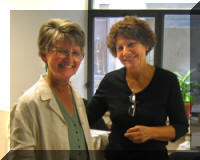
Franca Principe, on the right, IMSS
staff member, who took the
excellent photographs before and after the recent
restoration. |
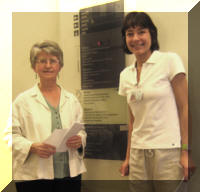
Karen Tomashavsky, IMSS staff member, who helped in
so many ways coordinating our visit and giving a
wonderful tour of the exhibits. |
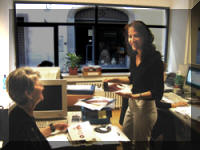
Sabina Bernacchini, IMSS staff
member, who helped
make available and processed the many request for
the photography. |
|
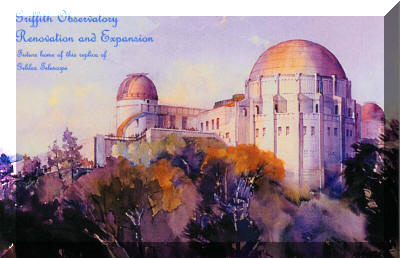
Replica of Galileo's Telescope for Griffith
Observatory
Picture taken from Friends of the Observatory
brochure Tel 818 846 3686
|
Galileo's Telescope Gathering
the dimensions, method of construction, and the gold tooling
design information.
|
.The
tools and methods we used for taking our measurements and photos
during our visit.
|
|
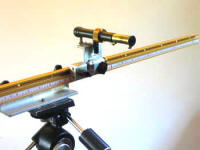
We built up a portable
measurement stand using a modified short focus
telescope with cross hairs and a 4 foot scale to
measure the dimensions of the telescope from
outside of the case. This device had a reading
precision of 1/5 mm but due to the distortion
of the roundness of Galileo's scope the diameter
measurements had less accuracy. We confirmed the
outside measurements of the lens holders but
found a meaningful difference, in the telescope
overall length as reported in the Catalogue of
Early Telescopes by A. Van Helden . The
significance of this difference is discussed in
the "Optics" section below. |
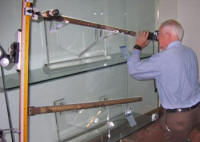
Substituting a camera for the
telescope, we took close up photos along the
telescope body, but for the most part we took
free hand shots. We used two 35 mm film cameras
with macro lenses and a digital camera capable
of a spatial resolution of 2592 X 1944 pixels to
record the gold and decorative art and make
relative size measurements. We focused at
two distances and several exposure levels. . We
did not have visible access to the back or
bottom of the scope. |
The
video.below
shows the original telescopes in their case at IMSS, one of our setups for taking the overall
dimensions, and views of the telescope while we
were taking our measurements and photos.
Click twice on the
play button below to see the streaming video.
|
Studying Galileo's Telescope in detail disclosed a
unique resin
composite construction. It is
not made of cardboard and paper as is often reported
in the literature This discovery gave us the
opportunity to study the methods and philosophy of
construction available to and generated by Galileo,
his associates, and assistants in their scientific
and engineering work. This work has raised some
interesting academic and replica questions. 1.Was it
designed for "mass production" by non skilled
labors? 2, was the eyepiece lens the only part
replaced or was the lens holder also changed?
Studying the original in some detail has helped us
in our mission to construct a much more faithful
reproduction inside and out of this famous Galileo
telescope for the Griffith Observatory.
|
As mentioned
earlier we were very fortunate in addition to our
measurements and photographs of this beautiful Galilean
telescope to also have access to excellent pictures taken
before and after a recent restoration. These pictures showed
that the internal construction of the telescope is not of
cardboard and paper but of wood and in a most novel way.
This opened to us a very rare opportunity of making a very
fine replica in the most complete and accurate detail even
to the interior. This accuracy of course helps to show the
inventiveness and creativity of how scientist worked in
1600. It shows along with its history the on going issues
and struggle of the basic research scientist trying to get
support for their research and acceptance of its results.
This telescope and its history shows ----Not only the
technical aspects of science ---- but the politics of
funding for basic research work, of the struggles in
convincing others to see the world more clearly from a
scientific measurement point of view. This telescope served
as a political tool as well as a discovery tool. It was
designed to impress people not of science but of power and
wealth by the richness of its decorative appearance. it was
also preformed well, 20 power, to show them his discoveries.
The data we collected were
vital in making a truly faithful replication of both inside
and the outside of this remarkable telescope. Many if not
all replicas of this telescope in the past have not had this
opportunity or not felt it worth while to go beyond the use
of cardboard, plastic or metal tubes and turned solid wood
lens holders none of which were used in the original
instrument. Some have had to replicate the telescopes
without accurate data thus including in some cases serious
errors in their replication. We believe that this is
unfortunate and scales down the broadness and richness of
what is to be learned from this telescope. We feel, perhaps
unfairly, that the lack of detail and authenticity only
increases the myopic view for some of what science is all
about.
|